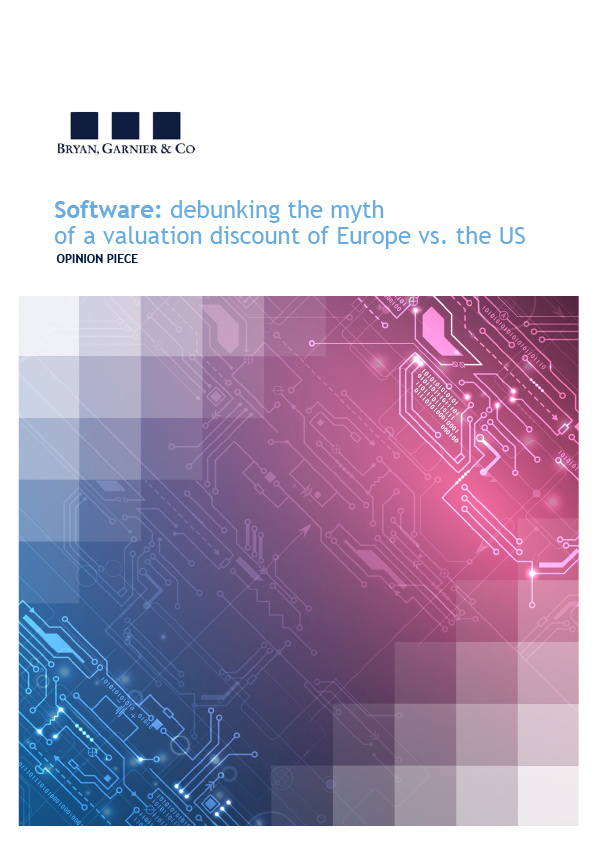Tech Innovations
Innovation is king. Tech companies build their performance on their ability to bring disruptive innovations to the market. At Bryan, Garnier, & Co we believe spotting the right business opportunities in technology relies on the ability to assess technological leadership as much as numbers. We foster deep technology expertise in our research organization, with a constant focus on emerging trends.
Telecoms & New Space
How to support an ever more connected world
Telecommunication networks and technologies are at the heart of society’s digitization. Computing power and Artificial Intelligence is useless without the right networking technologies to deliver information in the most reliable and timely manner. AR/VR and the metaverse, smart cities, industry 4.0 and autonomous vehicles can only develop alongside technological innovations on the networking front. In that context, bandwidth, latency and ubiquity are the key pillars of tomorrow’s telecommunication infrastructures. Only Fiber, 5G and new satellite technologies can address the needs of the next-generation digital services, and we see tremendous potential in these areas. While potential on the B2C side is difficult to assess, we believe opportunities in B2B are massive.
Managing Complexity
Creating and empowering data thanks to software
Software-as-a-service (SaaS) no longer has anything to prove. In North America, 70 of the top 100 software market caps have a native SaaS model, while the proportion is 30% in Europe but it is catching up as two-thirds of European software IPOs since early 2019 have been SaaS vendors. This huge success stems from its clear profitability once it has reached maturity: 5 out of the 10 largest SaaS firms are profitable. For their part, SaaS customers benefit from the flexibility of this business model: they can simply adjust the cost of consumption to the level of their business. In that context, traditional software vendors have started and even accelerated the transformation of their business model to SaaS and subscription at the expense of perpetual licensing, generating intense competition in the software industry. The related explosion of data has also opened the way for a new generation of data analytics available in the cloud.
Cybersecurity
The foundation of Digital Transformation
The Covid pandemic has led organizations to embrace new technologies at a faster pace than ever before. This emergence of increasingly distributed IT infrastructure, along with the explosion in its diversity and scale has greatly increased vulnerability to attacks. As a result, cybersecurity has become more critical for governments and corporations alike, especially in critical verticals such as healthcare or the industry. In this USD 130 billion industry, we see the unavoidable shift towards proactive cybersecurity continuing to gain momentum. At the same time, the need for automation tools and managed services, notably managed detection and response, will continue to increase as a way of dealing with the talent shortage in the industry. Consolidation is also likely to be a theme, either to improve the profitability (for services) or the offering. However, protecting the enterprise is no longer sufficient, and the protection of data and the applications themselves is gaining ground. Lastly, the importance of strong Customer Identity and Access Management (CIAM) solutions has never been as high as it currently is to help businesses grow.
Payments and Fintechs
Empowering the shift towards a cashless society
The covid-19 crisis shined a spotlight on payments and FinTech. For sanitary reasons, consumers have been invited to use contactless means of payments, thus accelerating their adoption. Furthermore, lockdowns and travel restrictions have boosted the use of electronic payment methods for e-commerce. However, although credit cards have been around for decades, cash-settled transactions still account for 40% of consumer payments volumes in Europe, while cash and checks represent 35% of corporate payment volumes globally. We deem the plethoric offer of technology-enabled payment solutions is likely to encourage consumers and businesses to further move away from cash, and implies a tremendous opportunity for digital payment progression as a whole. Having lagged the consumer-facing payment segment in terms of innovation, the B2B market is finally taking off in 2022. Indeed, the likes of privately-held Payfit, Quonto or Spendesk raised hundreds of millions of Euros (thereby exceeding the USD1bn valuation threshold) to tap into the significant opportunities offered by the B2B segment. As these players are merely scratching the surface of an underserved addressable market, we consider the digitization trend in the payments industry is set to accelerate, driven by changing behaviors, expanding offers of FinTech-led payment solutions, and more constraining legislations regarding the use of cash.
B2B Telecoms
At the core of enterprise digital transformation
Mainstream telecom operators have had a hard time monetizing heavy investment over the last 10 years, resulting in less attractive profiles for investors. However, in the midst of a depressed sector, the B2B telecom sub-segment offers highly attractive growth opportunities and deserves greater attention from investors in our opinion. As corporates digitalize, technological migrations are opportunities for alternative B2B players to take market share from incumbent operators and deliver double-digit organic growth. Adjacent services such as cloud or cybersecurity, as well as new technologies such as VoIP, unified communications, fibre and SD-WAN, are all challenging legacy services and providers and opening opportunities for smaller players. M&A is set to continue in the sector as investors look for recurring revenue and growth. At the same time, all B2B operators are seeking to accelerate their development, gain scale in distribution or with their services portfolio, and seize the growth opportunities presented by technology transformation.











